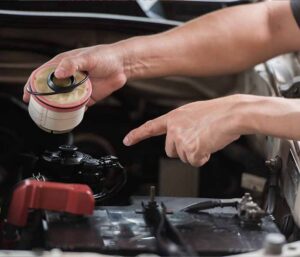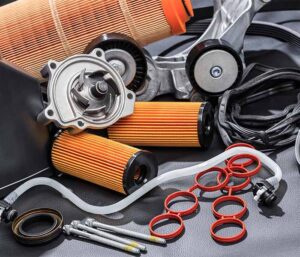Under the wave of intelligence, the automotive filter industry is undergoing a new transformation
I. Automotive Filters: From the Mechanical Era to the Intelligent Era
Traditional automotive filters primarily filter impurities from air, fuel, and oil, protecting the engine and passengers. However, with the growing trends toward smart cars, autonomous driving, and electrification, traditional mechanical filters are no longer able to meet the high standards of “intelligence, safety, and environmental protection” required of future vehicles. The automotive filter industry is gradually evolving from passive filtration to active sensing, intelligent monitoring, and data feedback, entering a truly “intelligent” era.
II. Three Core Capabilities of Smart Filters
- Sensing: Filters Can “Think”
Smart automotive filters are equipped with sensors that monitor parameters such as air flow, particle concentration, filter element resistance, humidity, and temperature in real time. If an anomaly (such as filter clogs or air intake abnormalities) occurs, the system automatically issues an alarm and triggers adjustments in the engine management system, thereby improving engine efficiency, extending service life, and ensuring driving safety. - Data Interaction: Filters Connect to the Internet of Vehicles
Modern smart filters can connect to the vehicle’s central control system or onboard computer system via CAN bus or Bluetooth for data synchronization. This not only provides drivers with real-time monitoring data but also provides a scientific basis for after-sales maintenance, reminding users to replace filters promptly and even enabling remote diagnosis and early warning, truly achieving “data-driven proactive maintenance.” - Adaptive Control: Intelligently Matching Operating Conditions
With the application of AI technology, some high-end filters can implement adaptive filtration strategies. The system automatically optimizes the filtration path and windage control based on regional air quality, driving habits, and vehicle speed, achieving the optimal balance between filtration efficiency and energy consumption. For example, in the dusty Middle East or the high humidity and high temperature environments of Southeast Asia, the filter can automatically switch to “enhanced filtration mode.”
III. Four Technological Breakthroughs in Smart Filters
- Nanomaterials + Multi-layer Composite Filter Structure
Traditional filter paper is being gradually replaced by nanofiber materials, multi-layer non-woven fabrics, and activated carbon composite structures. These new materials offer higher filtration accuracy (up to 0.1μm) while maintaining excellent air permeability and a longer service life, making them suitable for filtering a variety of pollutants, including PM2.5, ozone, and formaldehyde. - Intelligent Sensing System Integration
Current mainstream smart filters incorporate built-in particulate matter sensors, pressure sensors, and gas detection modules, and even incorporate AI algorithms to predict pollution trends and calculate replacement cycles. Leading technology manufacturers such as Dunwei and Bosch have compacted the sensor modules into the filter element itself, without compromising the structural design. - Automatic Identification + Intelligent Replacement Reminder
By interacting with sensors and onboard systems, smart filters can accurately identify filter blockage and abnormal air quality, and notify users via the vehicle’s computer system or app when to replace the filter. Some systems also integrate with after-sales services to schedule maintenance services in advance, enhancing the user experience. - Cloud Connectivity and Big Data Analysis
High-end filter products are integrated into the automaker’s cloud platform, continuously collecting usage data from various global vehicle models and optimizing filter element design through AI learning algorithms. This data feed helps companies understand pollution distribution and filter life characteristics in different regions, thereby implementing personalized filtration solutions.
IV. Smart Filter Application Scenarios Expand
- Passenger Car Market: Healthy Cockpits Accelerate Implementation
Smart filters are becoming a crucial component of “healthy cockpit” systems. Combined with components like negative ion purifiers and smart fragrances, they provide users with a fresh and safe in-car air environment, enhancing the brand’s premium image. - Commercial Vehicles and Logistics: Improving Operational and Maintenance Efficiency
Commercial vehicles are frequently driven and operate in harsh environments. Smart filters can significantly extend maintenance cycles, reduce downtime, and prevent sudden failures through early warning mechanisms, facilitating digital fleet management. - Electric Vehicles: Prioritizing Energy Efficiency and Environmental Protection
Pure electric vehicles are more sensitive to energy consumption control. Smart filters, through adaptive airflow control, effectively reduce air conditioning system energy consumption, while meeting both environmental and passenger health requirements. - Emerging Markets: High-dust Regions such as the Middle East, Southeast Asia, and Africa
Air quality in these regions fluctuates significantly, making traditional filters prone to frequent clogging. Smart filters automatically detect dust load levels and adjust their operating conditions, significantly improving filtration efficiency and product lifespan.
V. Future Trends: Increasing Commercial Value of Smart Filters
- Upgrading from “Consumables” to “Smart Hardware”
Smart filters will evolve from passive consumables to active electronic devices, equipped with networking, sensing, and self-learning capabilities, becoming part of the vehicle’s intelligent system. - Empowering the Aftermarket: Opening a New Path for Digital Operations and Maintenance
By leveraging real-time filter data transmission, analysis, and prediction, the automotive aftermarket can offer services such as “smart maintenance packages” and “on-demand replacement packages,” increasing customer retention and profitability. - Strengthening OEM Collaboration
More and more automakers are incorporating smart filters into their vehicle procurement systems, forming a collaborative “OEM + filter manufacturer + cloud platform” model and promoting the standardization of industry standards.
VI. Conclusion: Intelligence is the irreversible development trend of the filter industry.
Automotive filters are no longer simply filtration devices; they are intelligent nodes with “neuron” functionality. Those who pioneer and master core sensing and algorithm technologies will occupy a crucial position in the future automotive intelligent ecosystem.
With the widespread adoption of intelligent connected vehicles, user demand for healthy, safe, and intelligent in-car cleaning will continue to grow. Smart filters will become the “air guardians” of the next generation of vehicles. From manufacturing technology to user experience, from material upgrades to data applications, the automotive filter industry is ushering in a new era of comprehensive transformation.




